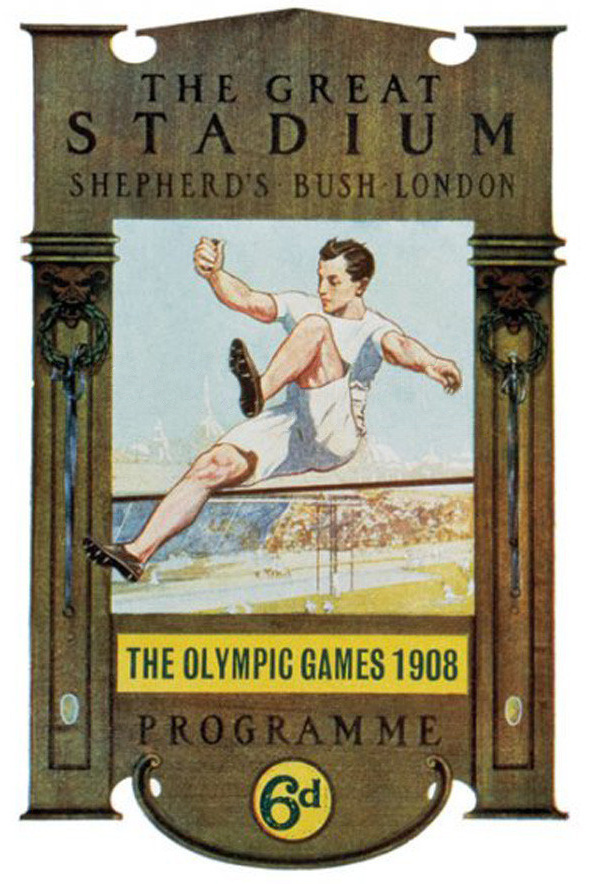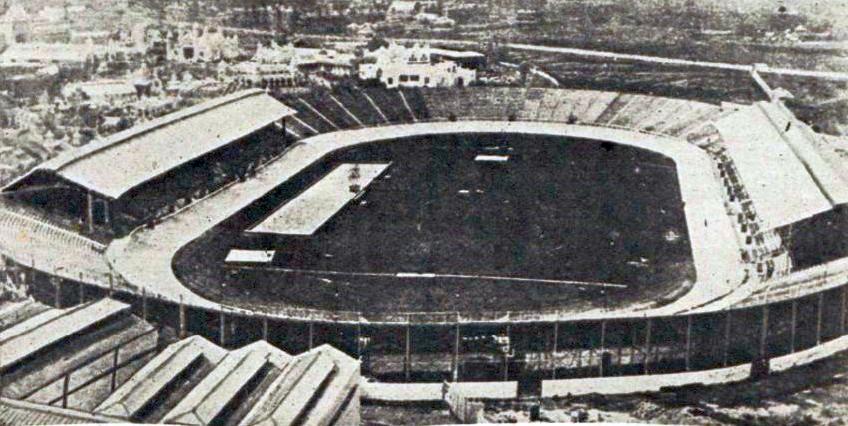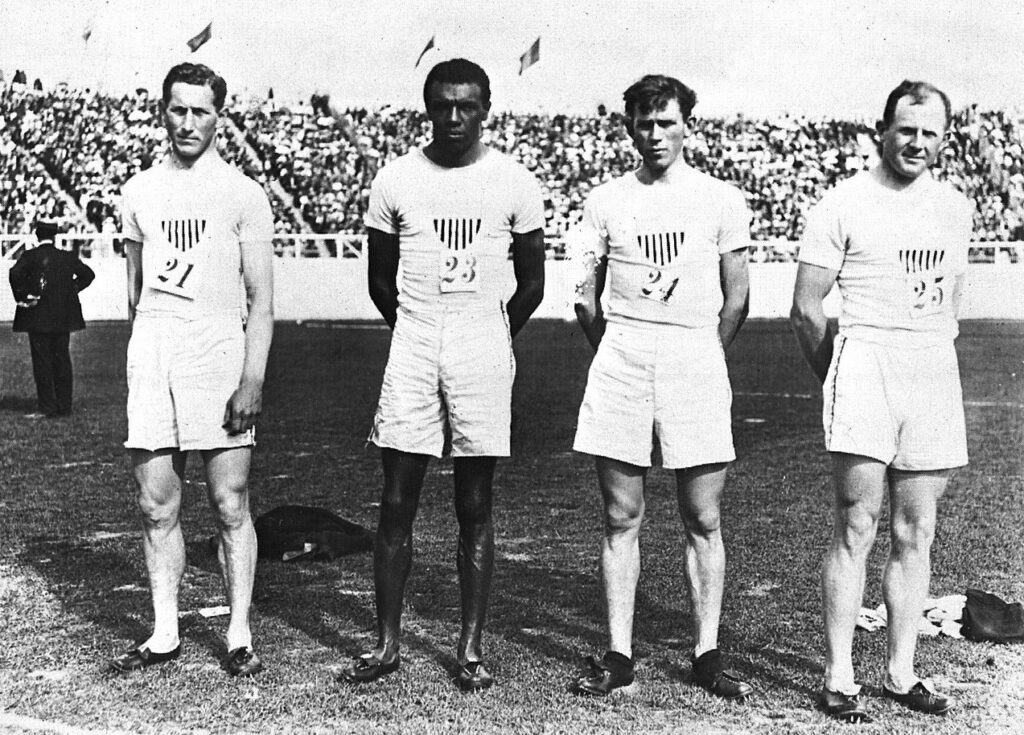Some notable happenings associated with the IV Olympiad – London 1908.
Initially awarded to Rome, the Games of the IV Olympiad were moved to London after Mount Vesuvius erupted on 7 April 1906, devastating the city of Naples and requiring the Italian government to redirect it’s resources to rebuilding that city rather than preparing to host the Olympics.
[Poster image from Wikimedia Commons – Public Domain.]
The British not only welcomed the Games but responded by constructing a new venue – the 68,000 seat White City Stadium. One lap around the stadium track was 536.448 meters or three laps per mile (the current 400 meter lap became the standard in 1962) and the stadium had a pool for aquatics and platforms for wrestling and gymnastics in its center field.
In addition to aquatics (swimming, diving, and the water polo final), wrestling, and gymnastics, White Stadium hosted the competitions in archery, athletics, field hockey, football, lacrosse, rugby union, track cycling, and tug of war.
[Photo from Wikimedia Commons – Public Domain.]
The Games of the Fourth Olympiad were the first Olympics to host a nascent opening ceremony – a parade of nations behind their national flag. However, even then this wasn’t without controversy. The Swedes refused to march because the Swedish flag wasn’t among those flying above the stadium. Finland was still part of the Russian Empire but many Finns marched behind no flag rather than entering behind the Russian flag. Ralph Rose refused to dip the American flag to King Edward VII.
(While we will never know with certainty what he was thinking, the story that Rose said, “this flag dips to no earthly King” appears to be apocryphal. Asked about the incident Martin Sheridan, who was born in Ireland, is alleged to have reported Rose saying this. However Sheridan, who died a casualty of the 1918 flu pandemic at age 37, never mentioned Rose saying this in any of his extensive notes about his Olympic experience. In fact, according to David Wallachensky’s The Complete Book of the Summer Olympics, the first time the alleged quote appears in writing is in 1952. Coincidentally {or perhaps not} this timing coincides with the increasing tensions between East and West commonly called the Cold War that most sources cite as beginning with the issuance of the Truman Doctrine on 12 March 1947.)
Twenty-two National Olympic Committees sent a total of 2,008 athletes (37 of whom were women) to compete in 110 events.
Australia and New Zealand competed as a unified team under the moniker Australasia.
Some competition highlights.
The single elimination Greco-Roman wrestling competition featured 21 competitors. In his semifinal against Mauritz Andersson of Sweden, Denmark’s Jóhannes Jóseppson broke his arm and had to withdraw. He was unable to compete for the bonze medal. Although Andersson’s Swedish teammate Frithiof Mårtensson won the other semifinal, he too suffered an injury – albeit a minor one. Andersson agreed to delay the final by a day to allow Mårtensson a chance to recover. This act of sportsmanship might have cost him a gold medal as Mårtensson won in a fall.
There was a lacrosse competition for the second and to date final time at an Olympic Games. Three teams had entered the previous tournament in Saint Louis in 1904. Only two teams – one from Great Britain and one from Canada competed in 1908 with the Canadian team claiming its second consecutive gold medal.
The track competition featured a medley relay. Four runners competed with two running 200 meters, one running 400 meters, and one running 800 meters. William Hamilton and Nate Cartmell ran the 200 meter legs. John Taylor ran the 400 and Mel Sheppard ran the 800 for the gold medal winning American team. Taylor, who had graduated earlier that year from the University of Pennsylvania School of Veterinary Medicine and was the son of freed slaves, became the first African American to win an Olympic gold medal.
[Photo from Wikimedia Commons – Public domain.]
Taylor died of typhoid fever less than five months later. In his obituary, the New York Times called him, “the world’s greatest negro runner.”
Sheppard, third from the left in the photo above was one of the stars of the first London Games. In addition to winning the relay gold medal, he won both the 1,500 and 800 meter races. His winning time of 1:52.4 in the 800 meters set a new world record.
Britain’s Wyndham Halswelle was the only medalist in the 400 meter race. After America’s John Carpenter was disqualified by British officials for “interference”, they scheduled a repeat of the final for the following day. The Americans insisted that Carpenter’s actions were not interference under American racing rules. The other two finalists, Taylor and William Robbins, both Americans, refused to run in the second final leaving Halswelle as the only medalist.
The official distance of the marathon – 26 miles 385 yards – was set during these Games. Originally planned to be a 25 mile race, the distance was changed so the race could start under the windows of the Royal Nursery at Windsor Castle at the request of Princess Mary. British officials who “felt compelled to restore the importance of the monarchy” moved the finish line to ensure the race finished in front of the King. It became the official marathon distance in 1924.
This race also generated perhaps the most famous athletic moment of the Games when Italian runner Dorando Pietri entered the stadium:.
Pietri fell five times and umpires provided assistance in each instance. In support of Johnny Hayes who had finished second just over 30 seconds behind Pietri, the American team lodged a complaint that was upheld and Pietri was disqualified for receiving aid. Hayes was awarded the gold medal.
These were the first Olympics to include a winter event – figure skating – making it the longest Olympic Games in history. Although he had not yet invented his eponymous jump in which a skater takes off from the back inside edge of one foot and lands on the back outside edge of the other foot, the men’s winner was Ulrich Salchow from Sweden. Great Britain’s Florence Syers won the women’s gold medal.
While most of the competition was held in April 1908, the four figure skating events were held in October and brought the Olympics to a quiet close after 187 days.



Now I know the reason the marathon is 26 miles 385 yards. The vanity of a king.
I also learned that John Taylor was the first African American to win an Olympic gold medal. Seems to me that this would be a good bar bet as I think most people, if they had a guess at all, would choose Jesse Owens who was well known and beloved for allegedly pissing off Hitler and his Aryan buddies at the 1936 games in Berlin. However, Owens said that he was actually snubbed by FDR, not Hitler, and that Adolph gave him a friendly Nazi salute and they exchanged congratulatory waves.
TBH, the FDR snub is a piece of trivia I didn’t know – not that it’s overly surprising.
Nary a congratulatory telegram…let alone an invitation to the White House….Like all the other Olympic heroes…..and probably the few heroines who were allowed to compete and won medals….